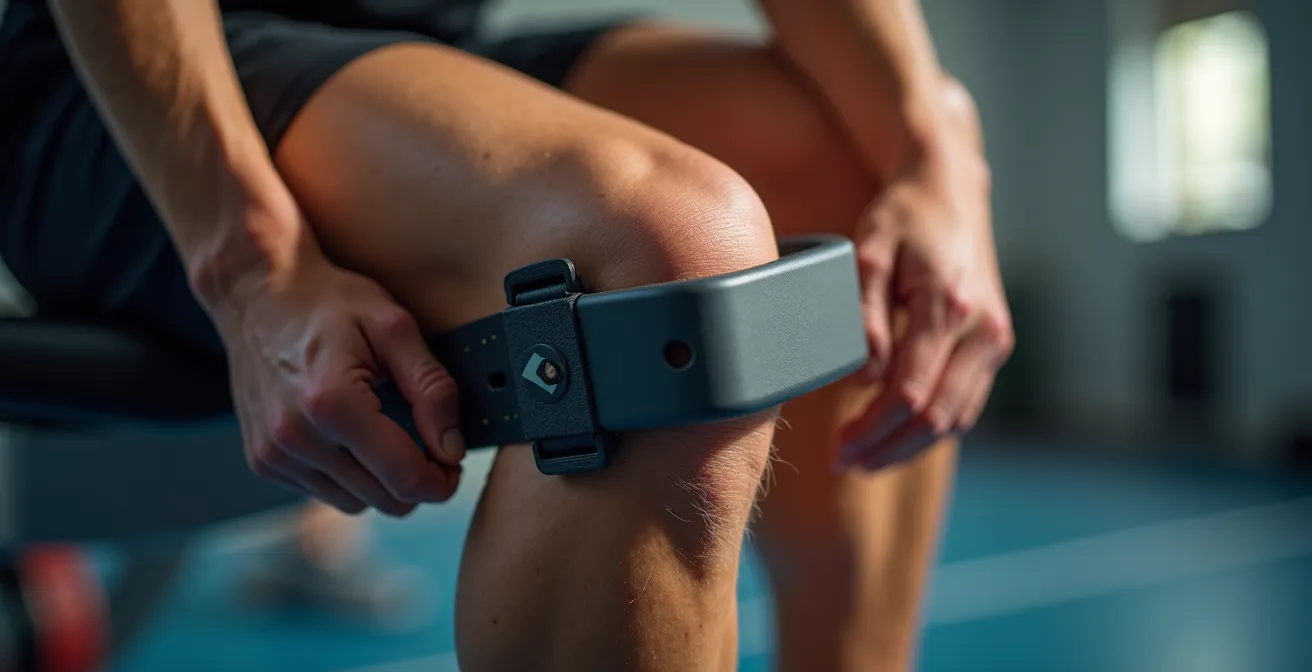For any athlete, the body is the ultimate instrument. But when a subtle twinge appears in the knee, the default instinct is often to push through, dismissing it as a minor annoyance. The common perception is that a surgeon is a last resort—a professional to see only when the damage is severe and the scalpel is unavoidable. This reactive mindset, however, is one of the greatest threats to an athletic career.
Viewing a knee specialist not as a mere operator but as a strategic partner in performance and longevity is a critical shift. Their expertise extends far beyond the operating room, offering a proactive approach to injury prevention, precision diagnostics, and long-term joint health. Engaging with a specialist in knee surgery and sports traumatology at the first sign of trouble doesn’t just address a symptom; it safeguards your entire athletic future.
Your Career Preservation Checklist
- Understand the surgeon’s role in proactive injury prevention, not just reactive treatment.
- Recognize how unaddressed minor knee issues create a cascade of more severe problems.
- Leverage precision diagnostics to uncover hidden damage before it becomes critical.
- Develop a strategic return-to-play plan that prioritizes long-term performance.
Beyond immediate pain: the surgeon’s role in proactive injury prevention
A knee surgeon’s true value for an athlete begins long before an injury becomes catastrophic. Their specialized knowledge allows them to analyze an athlete’s unique biomechanics and sport-specific movements to identify underlying risk factors that often go unnoticed. This involves assessing everything from gait and alignment to muscle imbalances that could predispose the knee to future damage.
Early consultation enables preemptive strategies that can avert serious injury. A surgeon can recommend targeted strengthening exercises, subtle corrections in form, or custom orthotics to address minor alignment issues before they evolve into ligament tears or cartilage damage. This level of insight into structural integrity and long-term joint health is what differentiates a knee specialist from general sports medicine advice, shifting the focus from treatment to proactive preservation.
This proactive approach involves a systematic evaluation to build a foundation for resilience. By understanding the athlete’s specific needs, a specialist can implement a clear plan for prevention.
Steps for Proactive Knee Injury Prevention
- Step 1: Conduct a sport-specific biomechanical assessment.
- Step 2: Implement targeted strengthening and balance exercises.
- Step 3: Monitor for subtle alignment issues with regular follow-ups.
- Step 4: Educate athletes about early warning signs and prevention.
The core of this preventative strategy is identifying and correcting minute flaws in an athlete’s mechanics. These adjustments are often subtle but have a profound impact on how forces are distributed across the knee joint during high-impact movements, effectively reducing the risk of wear and tear.

Ultimately, this partnership transforms the surgeon from a reactive problem-solver into an essential architect of an athlete’s physical longevity, ensuring their joints can withstand the rigors of their sport for years to come.
The cascading effect: how unaddressed knee issues can derail a career
A seemingly minor knee irritation is rarely an isolated issue. To avoid pain, the body instinctively creates compensatory movements, shifting stress to other joints and muscles. This chain reaction can lead to secondary problems in the hips, ankles, or lower back, creating a complex web of biomechanical dysfunction that is much harder to resolve.
This situation is further complicated by the fact that youth sports are seeing a concerning 12% increase in ACL injury rates annually. If not properly managed by a specialist, an acute injury can progress into chronic pain and, eventually, degenerative conditions like early-onset osteoarthritis. What started as a manageable issue can become a permanent limiter on performance. As one athlete shared, “Persistent knee pain forced me to change my movement patterns, which then caused problems in my hips and back. Early treatment could have saved my athletic career.”
The impact isn’t just physical. The psychological toll of a persistent knee issue can be debilitating, eroding an athlete’s confidence, creating hesitation, and ultimately affecting their ability to perform at their peak. This mental barrier can be just as career-threatening as the physical injury itself.
Ignoring these warning signs creates a snowball effect where the body’s interconnected systems begin to fail. Addressing the root cause with a specialist is the only way to break the cycle before it compromises an entire career.
Playing through knee pain increases the risk of severe injury and long-term joint degeneration, significantly impacting athletic longevity.
– International Spine, Pain & Performance Center, Athlete? Here’s Why You Shouldn’t Play Through Knee Pain
Precision diagnostics: uncovering hidden threats with a knee specialist
One of the most critical roles a knee surgeon plays is in precision diagnostics. While a standard physical exam can identify obvious injuries, specialists utilize advanced diagnostic tools and highly specific examination techniques to detect subtle meniscus tears, early cartilage damage, or minor ligament laxity that might otherwise be missed. This early detection is key to less invasive and more effective interventions.
The surgeon’s expertise is not just in ordering an MRI but in interpreting the results within the specific context of the athlete’s sport. They understand how seemingly small anomalies on a scan can translate into significant performance issues on the field or court, a nuance that is crucial for a correct diagnosis. This detailed analysis leads to a significant reduction in false negatives for meniscus damage compared to traditional imaging interpretation.
This meticulous diagnostic process provides the clarity needed for effective treatment and is fundamental to recovering from a knee injury completely, rather than just masking symptoms.

New technologies are further enhancing this diagnostic capability, allowing for earlier and more accurate identification of potential career-ending issues.
Early Diagnosis of Meniscus Injury Using Advanced Imaging and AI Techniques
A novel method combining MRI and deep learning models improved detection accuracy of subtle meniscus tears, allowing early and less invasive interventions. This approach demonstrates how technology aids specialists in identifying problems before they escalate, providing a crucial window for effective, joint-preserving treatment.
Dynamic knee testing provides quantifiable data on functional instability, going beyond manual exams for precise diagnosis.
– Théo Cojean et al., Arthrometer.com
Mapping your comeback: strategic planning for long-term athletic viability
Recovering from a knee injury is more than just waiting for the pain to subside. A surgeon plays a pivotal role in mapping out a strategic comeback plan that is both realistic and performance-oriented. They help define return-to-play timelines that go beyond simple healing, focusing instead on restoring full functional capacity required for the athlete’s specific discipline.
This involves developing progressive rehabilitation protocols tailored to prevent re-injury. As experts at Riverside Sports Therapy emphasize, a successful recovery hinges on this tailored approach and the constant coordination between the surgeon, physical therapist, and the athlete. This collaborative strategy ensures that every stage of recovery builds toward a safe and powerful return to sport.
A surgeon also provides guidance on long-term joint health management, offering strategies for training modifications and recovery techniques that optimize performance throughout an athlete’s career. The goal is not just to fix the immediate problem but to build a more resilient athlete.
Rehabilitation Planning Steps for Athletes
- Develop a personalized rehab plan with your knee surgeon and physical therapist.
- Set realistic return-to-play timelines based on injury and sport demands.
- Implement sport-specific strength and conditioning programs progressively.
- Monitor recovery milestones and adjust the plan to prevent re-injury.
The choice of rehabilitation approach is critical and depends on the athlete’s specific goals and injury type. A specialist can help navigate these options to create the most effective plan.
| Approach | Focus | Pros | Cons |
|---|---|---|---|
| Standard Physical Therapy | Joint mobility and pain management | Widely available | May lack sport-specific focus |
| Sports-Orthopedic Rehab | Functional strength, sport-specific movements | Targets athletic demands | Requires specialist expertise |
| Progressive Load Training | Prevent re-injury, build performance | Customizable schedule | Needs close monitoring |
This careful planning ensures that an athlete returns to their sport not just healed, but stronger and more aware of their body’s needs.
Returning to Sport Post Knee Reconstruction
Individualized planning focusing on gradual load increase and psychological readiness enabled athletes to return to competitive levels successfully after knee reconstruction. This highlights the importance of a comprehensive strategy that addresses both physical and mental aspects of recovery.
Key Takeaways
- A knee surgeon is a proactive partner for injury prevention, not just a reactive treater.
- Ignoring minor knee pain creates a chain reaction of biomechanical problems.
- Specialist diagnostics uncover hidden threats before they become career-ending injuries.
- Strategic, surgeon-led rehabilitation is crucial for a safe and powerful return to sport.
- A proactive mindset, focused on early consultation, is key to athletic longevity.
When to listen to your knee: recognizing the subtle signs before catastrophe
Pain is an obvious signal, but it’s not the only one. Athletes must learn to recognize subtle indicators of knee trouble, such as a feeling of instability, clicking sounds, persistent swelling after activity, or a noticeable decrease in range of motion or power. These are often the first signs of underlying structural issues that a specialist can identify and address.
The “play through the pain” mentality is incredibly risky. Research shows that up to 40% of athletes play through minor knee pain, unknowingly masking serious underlying problems and risking a much more severe injury. Early specialist intervention is critical to prevent further damage. The London Cartilage Clinic notes that early identification of these symptoms allows for timely intervention that can prevent long-term harm.
The best approach is to cultivate a proactive mindset. View a knee specialist as a trusted partner for regular risk assessment and performance enhancement, not just someone to see when things go wrong. Learning to listen to your body and seeking expert advice early is one of the most powerful things you can do to protect your career. Explore safe training practices to further enhance your understanding of injury prevention.
Here are some of the critical, non-pain symptoms that warrant a specialist consultation.
Checklist of Subtle Knee Injury Signs
- Persistent knee swelling or tightness after activity.
- Instability or sensation of the knee ‘giving way’.
- Locking or catching sensation in the joint.
- Decreased range of motion and stiffness.
These subtle signs are your body’s early warning system. Paying attention to them can be the difference between a minor adjustment and a season-ending surgery. By treating your relationship with a knee specialist as an ongoing alliance for health, you invest directly in your longevity and success as an athlete.
Frequently asked questions on sports injury recovery
What is the difference between a sports medicine doctor and an orthopedic knee surgeon?
A sports medicine doctor often focuses on non-operative treatments and general musculoskeletal health. An orthopedic knee surgeon has specialized training in the structural and biomechanical intricacies of the knee joint, allowing them to provide advanced diagnostics, perform surgery when necessary, and offer proactive strategies for long-term joint preservation.
Can I avoid surgery by seeing a surgeon early?
Absolutely. One of the main benefits of an early consultation is prevention. A surgeon can identify risk factors and intervene with non-operative strategies like targeted physical therapy, bracing, or form correction to address an issue before it deteriorates to the point where surgery is the only option.
What are the biggest risks of ignoring minor knee pain?
Ignoring minor knee pain can lead to a cascade of negative effects. Physically, it can cause compensatory movements that injure other joints and can progress into chronic conditions like osteoarthritis. Psychologically, it can erode confidence and performance, ultimately putting your entire athletic career at risk.
